Two Origins, Two Functions: The Discovery of Distinct Secretory Ducts Formed during the Primary and Secondary Growth in Kielmeyera
Abstract
1. Introduction
2. Results
2.1. Primary Ducts
2.2. Secondary Ducts
2.3. Secretion Composition
2.4. Chemical Analysis
3. Discussion
3.1. Distribution within the Plant
3.2. Duct Diversity
3.3. Origin and Metabolism
3.4. Function
3.5. Evolutionary Implications
4. Materials and Methods
4.1. Plant Material
4.2. Histological Analysis
4.3. Chemical Analysis
5. Conclusions
Supplementary Materials
Author Contributions
Funding
Institutional Review Board Statement
Informed Consent Statement
Data Availability Statement
Acknowledgments
Conflicts of Interest
References
- Fahn, A. Secretory Tissues in Plants; Academic Press: London, UK, 1979. [Google Scholar]
- Ciccarelli, D.; Andreucci, A.C.; Pagni, A.M. Translucent glands and secretory canals in Hypericum perforatum L. (Hypericaceae): Morphological, anatomical and histochemical studies during the course of ontogenesis. Ann. Bot. 2001, 88, 637–644. [Google Scholar] [CrossRef]
- Prado, E.; Demarco, D. Laticifers and secretory ducts: Similarities and differences. In Ecosystem Services and Global Ecology; Hufnagel, L., Ed.; IntechOpen: London, UK, 2018; pp. 103–123. [Google Scholar]
- Sykes, M.G. The anatomy and morphology of the leaves and inflorescences of Welwitschia mirabilis. Philos. T. Roy. Soc. B 1911, 201, 179–226. [Google Scholar]
- Swamy, B.G.L. The morphology and relationships of the Chloranthaceae. J. Arnold Arbor. 1953, 34, 375–411. [Google Scholar]
- Alverson, W.S.; Karol, K.G.; Baum, D.A.; Chase, M.W.; Swensen, S.M.; McCourt, R.; Sytsma, K.J. Circumscription of the Malvales and relationships to other Rosidae: Evidence from rbcL sequence data. Am. J. Bot. 1998, 85, 876–887. [Google Scholar] [CrossRef] [PubMed]
- Sajo, M.G.; Rudall, P.J. Leaf and stem anatomy of Vochysiaceae in relation to subfamilial and suprafamilial systematics. Bot. J. Linn. Soc. 2002, 138, 339–364. [Google Scholar] [CrossRef][Green Version]
- Tilney, P.M. A contribution to the leaf and young stem anatomy of the Combretaceae. Bot. J. Linn. Soc. 2002, 138, 163–196. [Google Scholar] [CrossRef]
- Metcalfe, C.R.; Chalk, L. Anatomy of the Dicotyledons: Leaves, Stem and Wood in Relation to Taxonomy with Notes on Economic Uses, 2 Volumes; Clarendon Press: Oxford, UK, 1950. [Google Scholar]
- Langenheim, J.H. Plant Resins: Chemistry, Evolution, Ecology and Ethnobotany; Timber Press: Portland, OR, USA, 2003. [Google Scholar]
- Castro, M.M.; Demarco, D. Phenolic compounds produced by secretory structures in plants: A brief review. Nat. Prod. Commun. 2008, 3, 1273–1284. [Google Scholar]
- Thadeo, M.; Meira, R.M.S.A.; Azevedo, A.A. Foliar anatomy of neotropical Salicaceae: Potentially useful characters for taxonomy. Plant Syst. Evol. 2014, 300, 2073–2089. [Google Scholar] [CrossRef]
- Garcia, T.B.; Costa, E.R.; Kikuchi, T.Y.S.; Aguiar-Dias, A.C.A.; Demarco, D. Coalescent cavities: A novel process of secretory duct formation in Theobroma L. (Malvaceae). In Plant Ontogeny: Studies, Analyses and Evolutionary Implications; Demarco, D., Ed.; Nova Science: New York, NY, USA, 2020; pp. 1–20. [Google Scholar]
- Tölke, E.D.; Lacchia, A.P.S.; Lima, E.A.; Demarco, D.; Ascensão, L.; Carmello-Guerreiro, S.M. Secretory ducts in Anacardiaceae revisited: Updated concepts and new findings based on histochemical evidence. S. Afr. J. Bot. 2021, 138, 394–405. [Google Scholar] [CrossRef]
- Lersten, N.R.; Curtis, J.D. Tubular cavities in white snakeroot, Eupatorium rugosum (Asteraceae). Am. J. Bot. 1986, 73, 1016–1021. [Google Scholar] [CrossRef]
- Rodrigues, T.M.; Machado, S.R. Developmental and structural features of secretory canals in root and shoot wood of Copaifera langsdorffii Desf. (Leguminosae–Caesalpinioideae). Trees 2009, 23, 1013–1018. [Google Scholar] [CrossRef]
- Bayer, C.; Kubitzki, K. Malvaceae. In Flowering plants. Dicotyledons. The Families and Genera of Vascular Plants; Kubitzki, K., Bayer, C., Eds.; Springer: Heidelberg, Germany, 2003; Volume 5, pp. 225–311. [Google Scholar]
- Venkaiah, K.; Shah, J.J. Distribution, development and structure of gum ducts in Lannea coromandelica (Houtt) Merril. Ann. Bot. 1984, 54, 175–186. [Google Scholar] [CrossRef]
- Pell, S.K.; Mitchell, J.D.; Miller, A.J.; Lobova, T.A. Anacardiaceae. In Flowering Plants. Eudicots. The Families and Genera of Vascular Plants; Kubitzki, K., Ed.; Springer: Heidelberg, Germany, 2011; Volume 10, pp. 7–50. [Google Scholar]
- Joel, D.M.; Fahn, A. Ultrastructure of resin ducts of Mangifera indica L. (Anacardiaceae). 1. Differentiation and senescence of the shoot ducts. Ann. Bot. 1980, 46, 225–233. [Google Scholar] [CrossRef]
- Joel, D.M.; Fahn, A. Ultrastructure of resin ducts of Mangifera indica L. (Anacardiaceae). 2. Resin secretion in the primary stem ducts. Ann. Bot. 1980, 46, 779–783. [Google Scholar] [CrossRef]
- Alves, T.M.A.; Silva, A.F.; Brandão, M.; Grandi, T.S.M.; Smânia, E.F.A.; Smânia Júnior, A.; Zani, C.L. Biological screening of Brazilian medicinal plants. Mem. Inst. Oswaldo Cruz 2000, 95, 367–373. [Google Scholar] [CrossRef]
- Cortez, D.A.G.; Abreu Filho, B.A.; Nakamura, C.V.; Dias Filho, B.P.; Marston, A.; Hostettmann, K. Antibacterial activity of a biphenyl and xanthones from Kielmeyera coriacea. Pharm. Biol. 2002, 40, 485–489. [Google Scholar] [CrossRef]
- Pinheiro, L.; Cortez, D.A.G.; Vidotti, G.J.; Young, M.C.M.E.; Ferreira, A.G. Estudo fitoquímico e avaliação da atividade moluscicida da Kielmeyera variabilis Mart. (Clusiaceae). Quim. Nova 2003, 26, 157–160. [Google Scholar] [CrossRef]
- Rizzini, C.T.; Mors, W.B. Botânica Econômica Brasileira; Universidade de São Paulo: São Paulo, Brazil, 1976. [Google Scholar]
- Cronquist, A. An Integrated System of Classification of Flowering Plants; Columbia University Press: New York, NY, USA, 1981. [Google Scholar]
- Mabberley, D.J. The Plant Book: A Portable Dictionary of the Vascular Plants; Cambridge University Press: London, UK, 1987. [Google Scholar]
- Zhang, A.; Wan, L.; Wu, C.; Fang, Y.; Han, G.; Li, H.; Zhang, Z.; Wang, H. Simultaneous determination of 14 phenolic compounds in grape canes by HPLC-DAD-UV using wavelength switching detection. Molecules 2013, 18, 14241–14257. [Google Scholar] [CrossRef]
- Wang, M.; Carver, J.J.; Phelan, V.V.; Sanchez, L.M.; Garg, N.; Peng, Y.; Nguyen, D.D.; Watrous, J.; Kapono, C.A.; Luzzatto-Knaan, T.; et al. Sharing and community curation of mass spectrometry data with Global Natural Products Social Molecular Networking. Nat. Biotechnol. 2016, 34, 828–837. [Google Scholar] [CrossRef]
- Medina, M.C.; Sousa-Baena, M.S.; Prado, E.; Acevedo-Rodríguez, P.; Dias, P.; Demarco, D. Laticifers in Sapindaceae: Structure, evolution and phylogenetic importance. Front. Plant Sci. 2021, 11, 612985. [Google Scholar] [CrossRef]
- Wu, H.; Hu, Z.H. Comparative anatomy of resin ducts of the Pinaceae. Trees 1997, 11, 135–143. [Google Scholar] [CrossRef]
- Joseph, J.P.; Shah, J.J.; Inamdar, J.A. Distribution, development and structure of resin ducts in guayule (Parthenium argentatum Gray). Ann. Bot. 1988, 61, 377–387. [Google Scholar] [CrossRef]
- Bhatt, J.R. Development and structure of primary secretory ducts in the stem of Commiphora wightii (Burseraceae). Ann. Bot. 1987, 405, 416–460. [Google Scholar] [CrossRef]
- Sato, K.; Ishida, S. Resin canals in the wood of Larix leptolepis Gord. II. Morphology of vertical resin canals. Res. Bull. Coll. Exp. For. 1982, 39, 297–326. [Google Scholar]
- Marcati, C.R.; Angyalossy-Alfonso, V.; Benetati, L. Anatomia comparada do lenho de Copaifera langsdorffii Desf. (Leguminosae-Caesalpinoideae) de floresta e cerradão. Rev. Bras. Bot. 2001, 24, 311–320. [Google Scholar] [CrossRef]
- Wiedenhoeft, A.C.; Miller, R.B. Brief comments on the nomenclature of softwood axial resin canals and their associated cells. IAWA J. 2002, 23, 299–303. [Google Scholar] [CrossRef]
- Carr, D.J.; Carr, S.G.M. Oil glands and ducts in Eucalyptus L’Hérit. II. Development and structure of oil glands in the embryo. Aust. J. Bot. 1970, 191, 212–218. [Google Scholar] [CrossRef]
- Turner, G.W.; Berry, A.M.; Gifford, E.M. Schizogenous secretory cavities of Citrus limon (L.) Burm. F. and a reevaluation of the lysigenous gland concept. Int. J. Plant Sci. 1998, 159, 75–88. [Google Scholar] [CrossRef]
- Turner, G.W. A brief history of the lysigenous gland hypothesis. Bot. Rev. 1999, 65, 76–88. [Google Scholar] [CrossRef]
- Venning, F.D. The ontogeny of laticiferous canals in the Anacardiaceae. Am. J. Bot. 1948, 35, 637–644. [Google Scholar] [CrossRef]
- Solereder, H. Systematic Anatomy of the Dicotyledons; Clarendon Press: Oxford, UK, 1908. [Google Scholar]
- Joel, D.M.; Fahn, A. Ultrastructure of resin ducts of Mangifera indica L. (Anacardiaceae). 3. Secretion of the protein polysaccharide mucilage in the fruit. Ann. Bot. 1980, 46, 785–790. [Google Scholar] [CrossRef]
- Nair, G.M.; Venkaiah, K.; Shah, J.J. Ultrastructure of gum-resin ducts in cashew (Anacardium occidentale). Ann. Bot. 1983, 51, 297–305. [Google Scholar] [CrossRef]
- Royo, V.A.; Mercadante-Simões, M.O.; Ribeiro, L.M.; Oliveira, D.A.; Aguiar, M.M.R.; Costa, E.R.; Ferreira, P.R.B. Anatomy, histochemistry, and antifungal activity of Anacardium humile (Anacardiaceae) leaf. Microsc. Microanal. 2015, 21, 1–13. [Google Scholar] [CrossRef]
- Trapp, S.; Croteau, R. Defensive resin biosynthesis in conifers. Annu. Rev. Plant Phys. 2001, 52, 689–724. [Google Scholar] [CrossRef]
- Cheng, A.X.; Lou, Y.G.; Mao, Y.B.; Lu, S.; Wang, L.J.; Chen, X.Y. Plant terpenoids: Biosynthesis and ecological functions. J. Integr. Plant Biol. 2007, 49, 179–186. [Google Scholar] [CrossRef]
- Ma, D.; Li, Y.; Zhang, J.; Wang, C.; Qin, H.; Ding, H.; Xie, Y.; Guo, T. Accumulation of phenolic compounds and expression profiles of phenolic acid biosynthesis-related genes in developing grains of white, purple, and red wheat. Front. Plant Sci. 2016, 7, 528. [Google Scholar] [CrossRef] [PubMed]
- Aharoni, A.; Giri, A.P.; Deuerlein, S.; Griepink, F.; Kogel, W.J.; Verstappen, F.W.A.; Verhoeven, H.A.; Jongsma, M.A.; Schwab, W.; Bouwmeester, H.J. Terpenoid metabolism in wild-type and transgenic Arabidopsis plants. Plant Cell 2003, 15, 2866–2884. [Google Scholar] [CrossRef] [PubMed]
- Dudareva, N.; Martin, D.; Kish, C.M.; Kolosova, N.; Gorenstein, N.; Fäldt, J.; Miller, B.; Bohlmannb, J. (E)-β-Ocimene and myrcene synthase genes of floral scent biosynthesis in snapdragon: Function and expression of three terpene synthase genes of a new terpene synthase subfamily. Plant Cell 2003, 15, 1227–1241. [Google Scholar] [CrossRef] [PubMed]
- Lu, S.; Xu, R.; Jia, J.W.; Pang, J.; Matsuda, S.P.T.; Chen, X.Y. Cloning and functional characterization of a β-pinene synthase from Artemisia annua that shows a circadian pattern of expression. Plant Physiol. 2002, 130, 477–486. [Google Scholar] [CrossRef]
- Theis, N.; Lerdau, M. The evolution of function in plant secondary metabolites. Int. J. Plant Sci. 2003, 164, S93–S102. [Google Scholar] [CrossRef]
- Gibson, A.C.; Nobel, P.S. The Cactus Primer; Harvard University Press: Cambridge, MA, USA, 1986. [Google Scholar]
- Meyberg, M. Cytochemistry and ultrastructure of the mucilage secreting trichomes of Nymphoides peltata (Menyanthaceae). Ann. Bot. 1988, 62, 537–547. [Google Scholar] [CrossRef]
- Mollenhauer, H.H. The fine structure of mucilage secreting cells of Hibiscus esculentus Pods. Protoplasma 1967, 63, 353–362. [Google Scholar] [CrossRef]
- Crawley, M.J. Herbivory: The Dynamics of Animal-Plant Interactions; Studies in Ecology; Blackwell Scientific Publications: Oxford, UK, 1983; Volume 10. [Google Scholar]
- Fernandes, V.F.; Thadeo, M.; Dalvi, V.C.; Marquete, R.; Silva, J.X.B.; Pereira, L.J.; Meira, R.M.S.A. How to distinguish cavities from ducts in Casearia Jacq. (Salicaceae): Anatomical characterization and distribution. Flora 2018, 240, 89–97. [Google Scholar] [CrossRef]
- Xi, Z.; Ruhfel, B.R.; Schaefer, H.; Amorim, A.M.; Sugumaran, M.; Wurdack, K.J.; Endress, P.K.; Matthews, M.L.; Stevens, P.F.; Mathews, S.; et al. Phylogenomics and a posteriori data partitioning resolve the Cretaceous angiosperm radiation Malpighiales. Proc. Natl. Acad. Sci. USA 2012, 109, 17519–17524. [Google Scholar] [CrossRef]
- Johansen, D.A. Plant Microtechnique; McGraw-Hill: New York, NY, USA, 1940. [Google Scholar]
- Gerlach, D. Botanische Mikrotechnik: Eine Einführung, 3rd ed.; Georg Thieme: Stuttgart, Germany, 1984. [Google Scholar]
- Pearse, A.G.E. Histochemistry: Theoretical and Applied; C. Livingstone: Edinburgh, UK, 1985. [Google Scholar]
- Kirk, P.W. Neutral red as a lipid fluorochrome. Stain Technol. 1970, 45, 1–4. [Google Scholar] [CrossRef]
- Cain, A.J. The use of Nile Blue in the examination of lipids. Q. J. Microsc. Sci. 1947, 88, 383–392. [Google Scholar]
- David, R.; Carde, J.P. Coloration différentielle des inclusions lipidique et terpénique des pseudophylles du Pin maritime au moyen du réactif de Nadi. C. R. Hebd. Acad. Sci. 1964, 258, 1338–1340. [Google Scholar]
- Ganter, P.; Jollés, G. Histochimie Normale et Pathologique, Volume 1; Gauthier-Villars: Paris, France, 1969. [Google Scholar]
- Ganter, P.; Jollés, G. Histochimie Normale et Pathologique, Volume 2; Gauthier-Villars: Paris, France, 1970. [Google Scholar]
- Gabe, M. Techniques Histologiques; Masson & Cie.: Paris, France, 1968. [Google Scholar]
- Mace, M.E.; Howell, C.R. Histochemistry and identification of condensed tannin precursor in roots of cotton seedlings. Can. J. Bot. 1974, 52, 2423–2426. [Google Scholar] [CrossRef]
- Gardner, R.O. Vanillin-hydrochloric acid as a histochemical test for tannin. Stain Technol. 1975, 50, 3715–3717. [Google Scholar] [CrossRef] [PubMed]
- Svendsen, A.B.; Verpoorte, R. Chromatography of Alkaloids; Elsevier: New York, NY, USA, 1983. [Google Scholar]
- Furr, M.; Mahlberg, P.G. Histochemical analyses of laticifers and glandular trichomes in Cannabis sativa. J. Nat. Prod. 1981, 44, 153–159. [Google Scholar] [CrossRef]
- Jensen, W.A. Botanical histochemistry. Principles and Practices; W. H. Freeman and Co.: San Francisco, CA, USA, 1962. [Google Scholar]
- Gregory, M.; Baas, P. A survey of mucilage cells in vegetative organs of the dicotyledons. Isr. J. Bot. 1989, 38, 125–174. [Google Scholar]
- Pizzolato, T.D. Staining of Tilia mucilages with Mayer’s tannic acid-ferric chloride. Bull. Torrey Bot. Club 1977, 104, 277–279. [Google Scholar] [CrossRef]
- Fisher, D.B. Protein staining of ribboned epon sections for light microscopy. Histochemie 1968, 16, 92–96. [Google Scholar] [CrossRef] [PubMed]
- Demarco, D. Histochemical analysis of plant secretory structures. In Histochemistry of Single Molecules. Methods in Molecular Biology; Pellicciari, C., Biggiogera, M., Eds.; Humana Press: New York, NY, USA, 2017; Volume 1560, pp. 313–330. [Google Scholar]
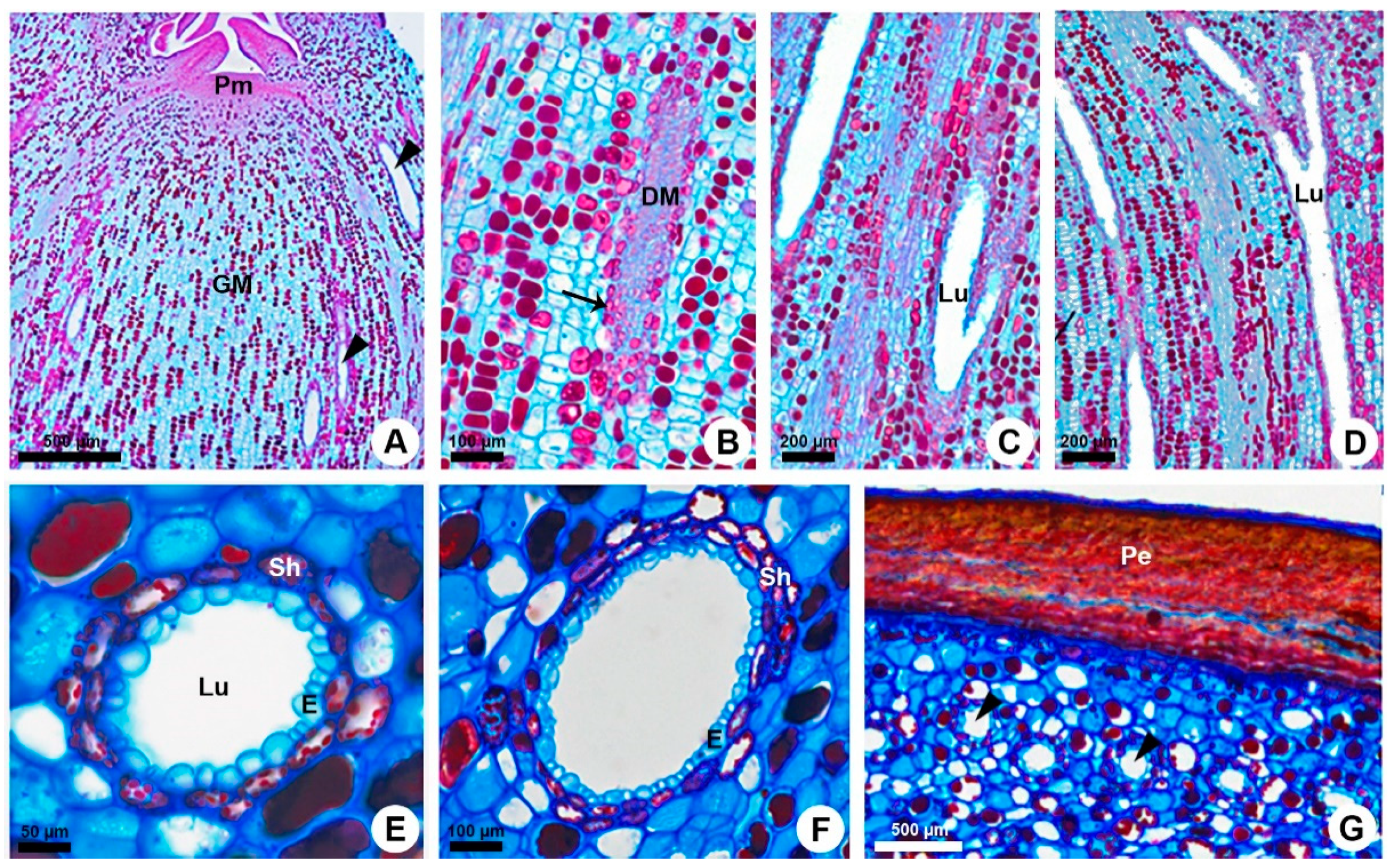
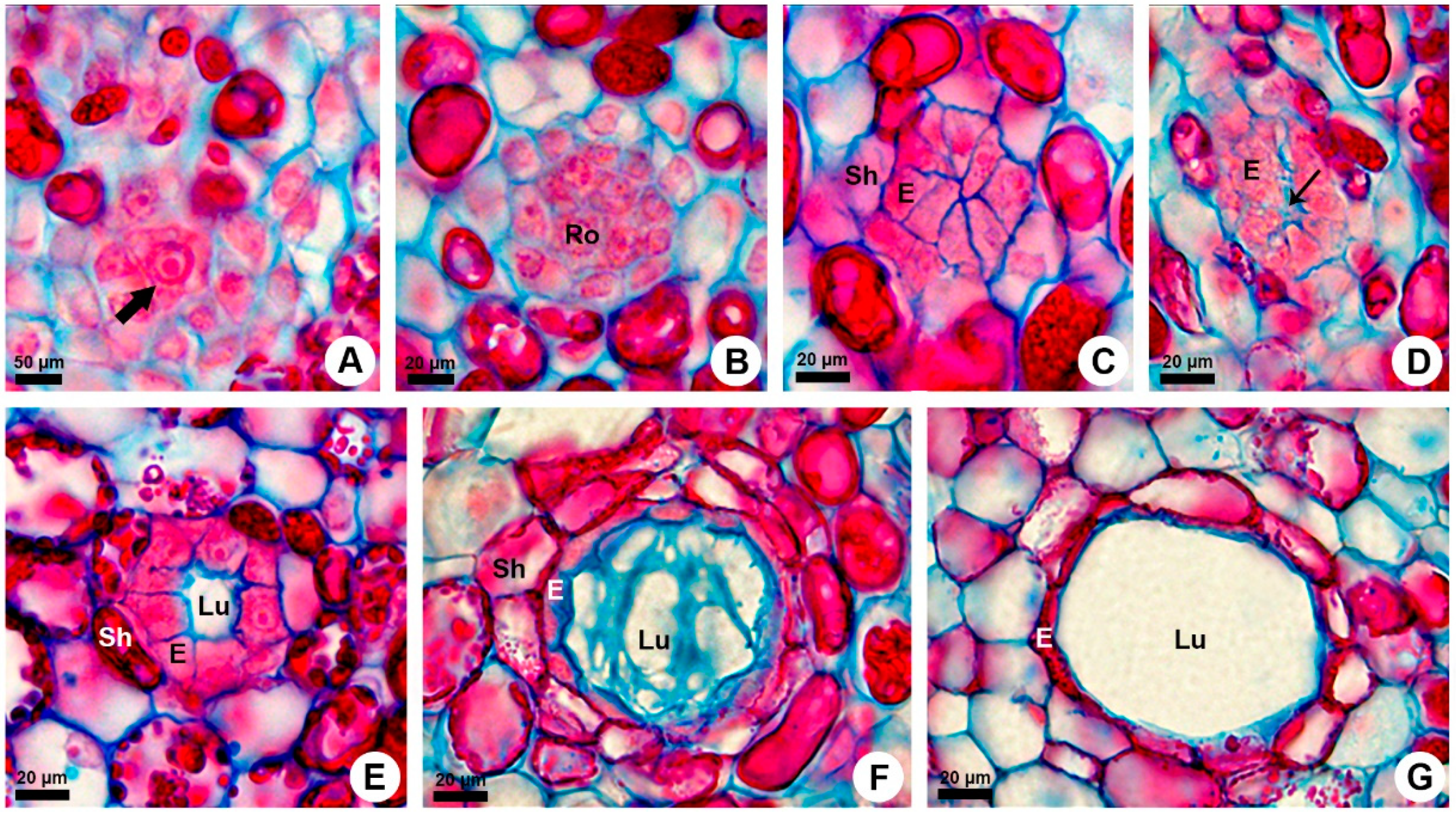
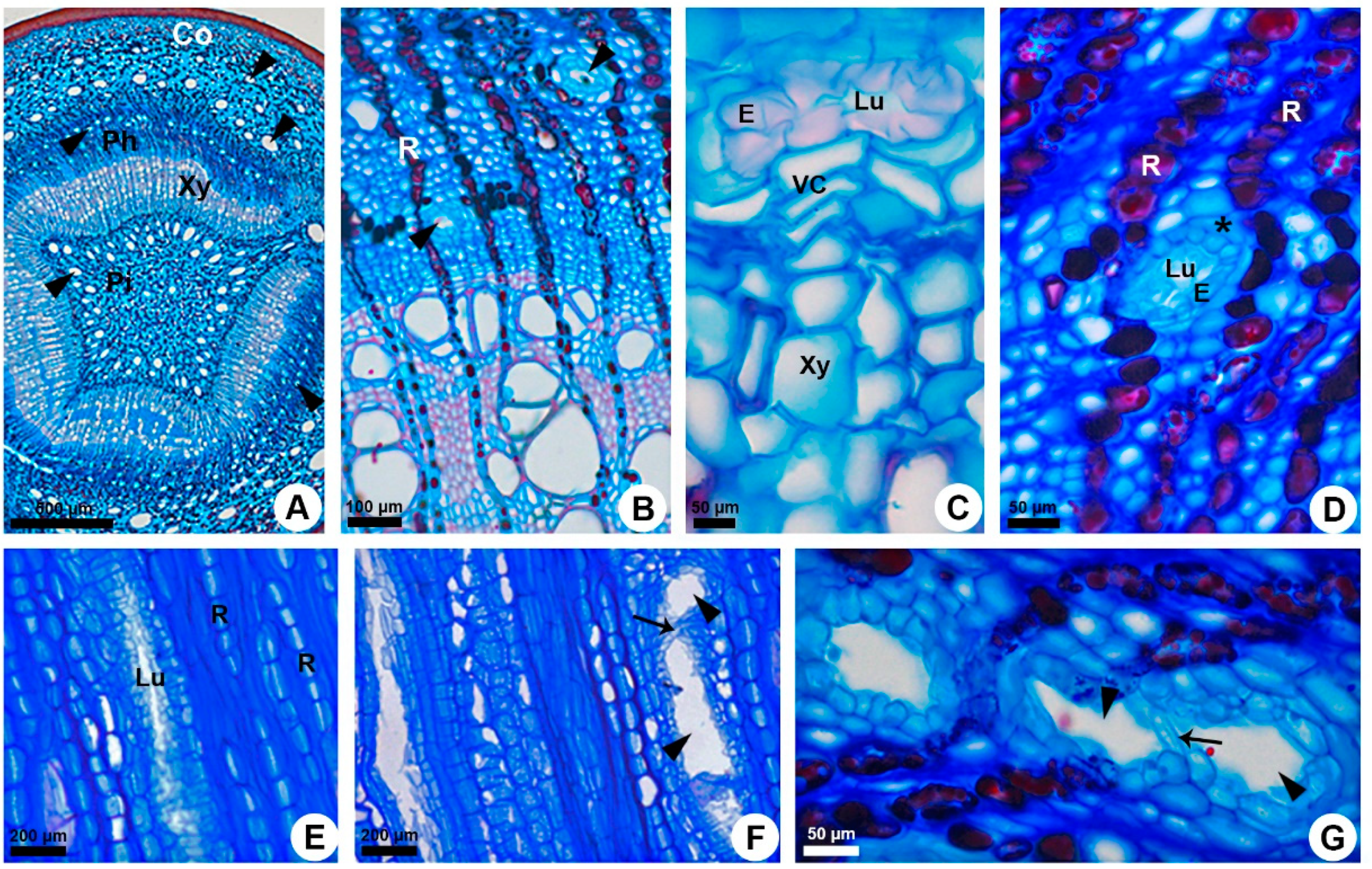
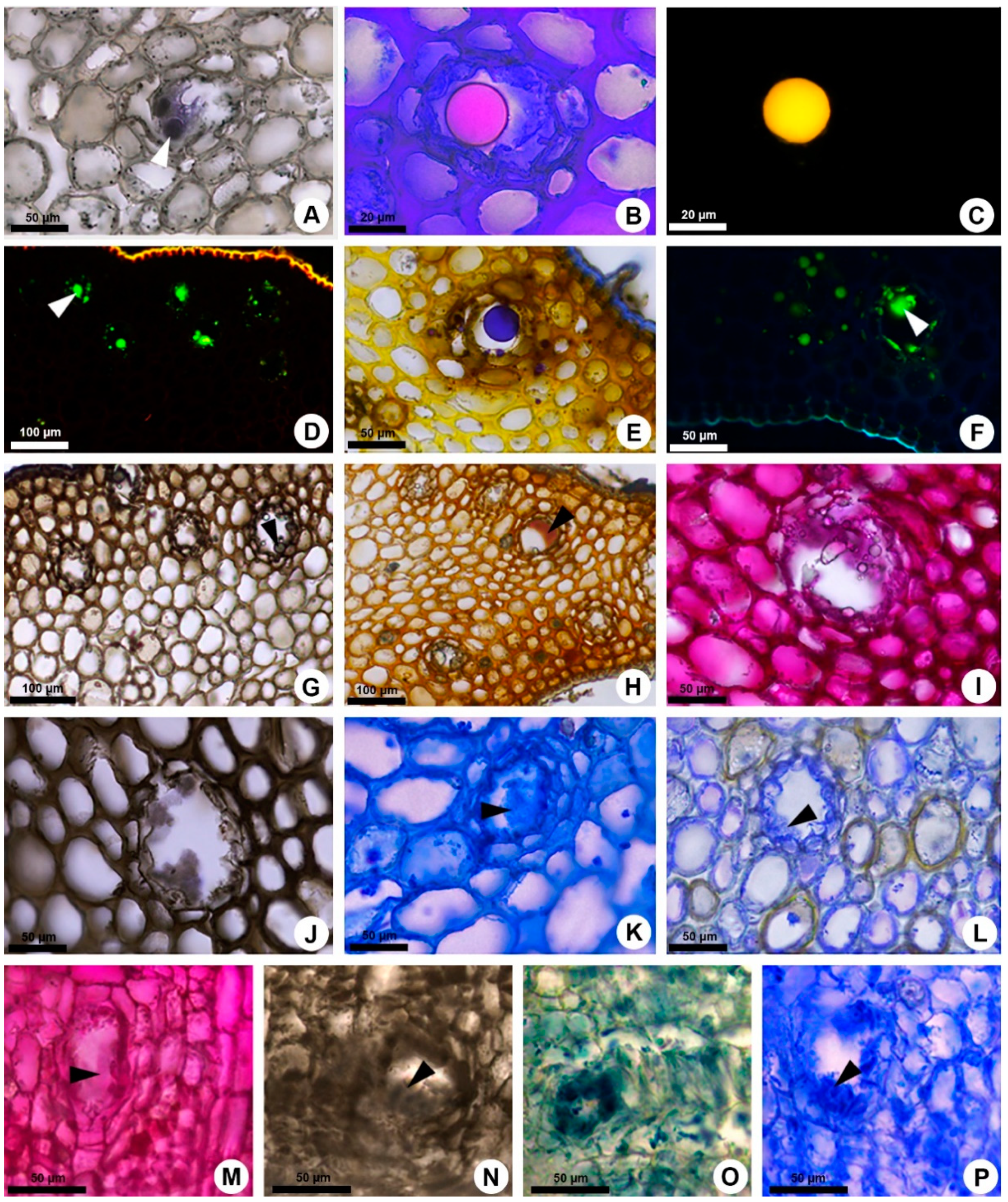
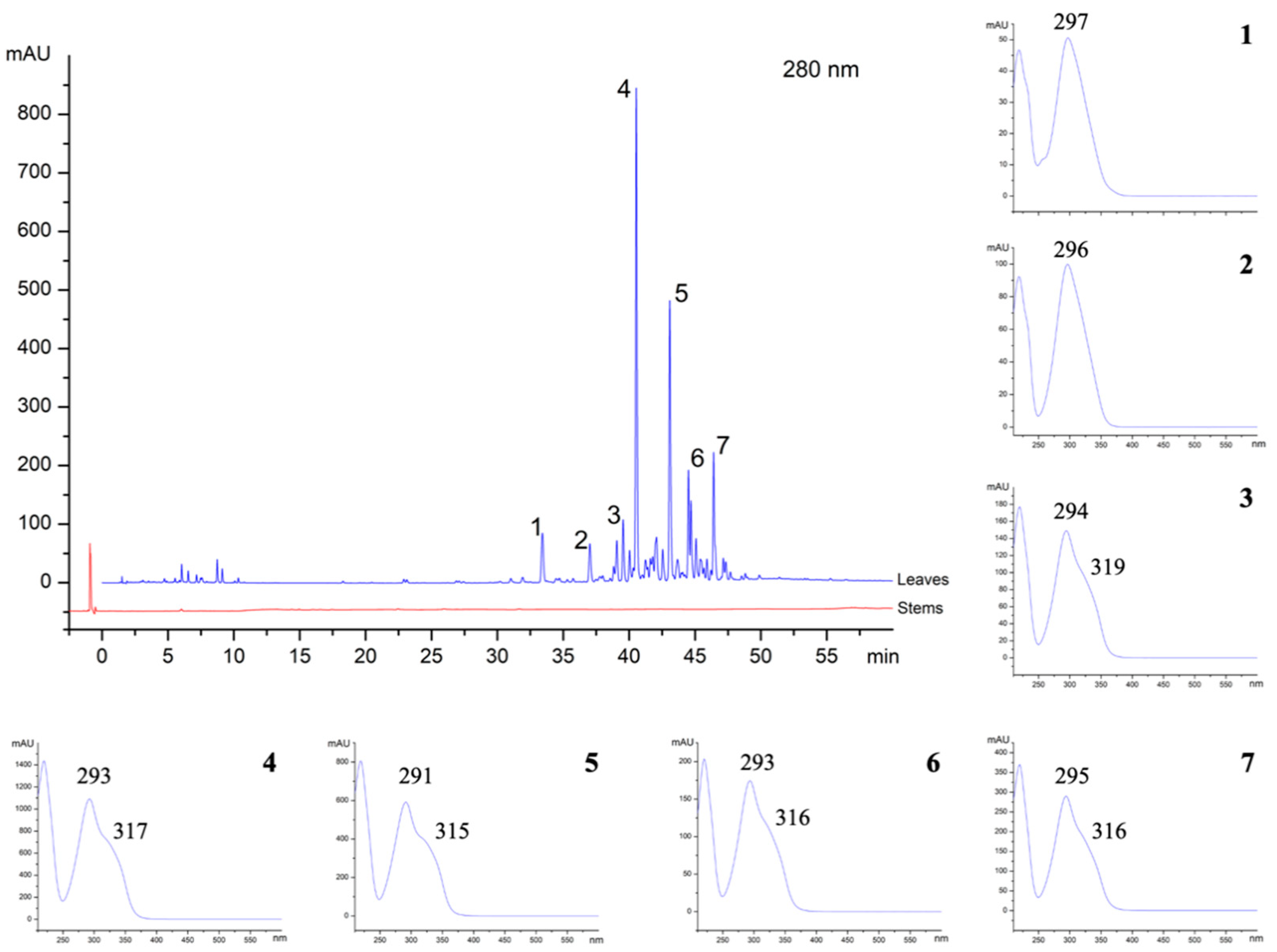
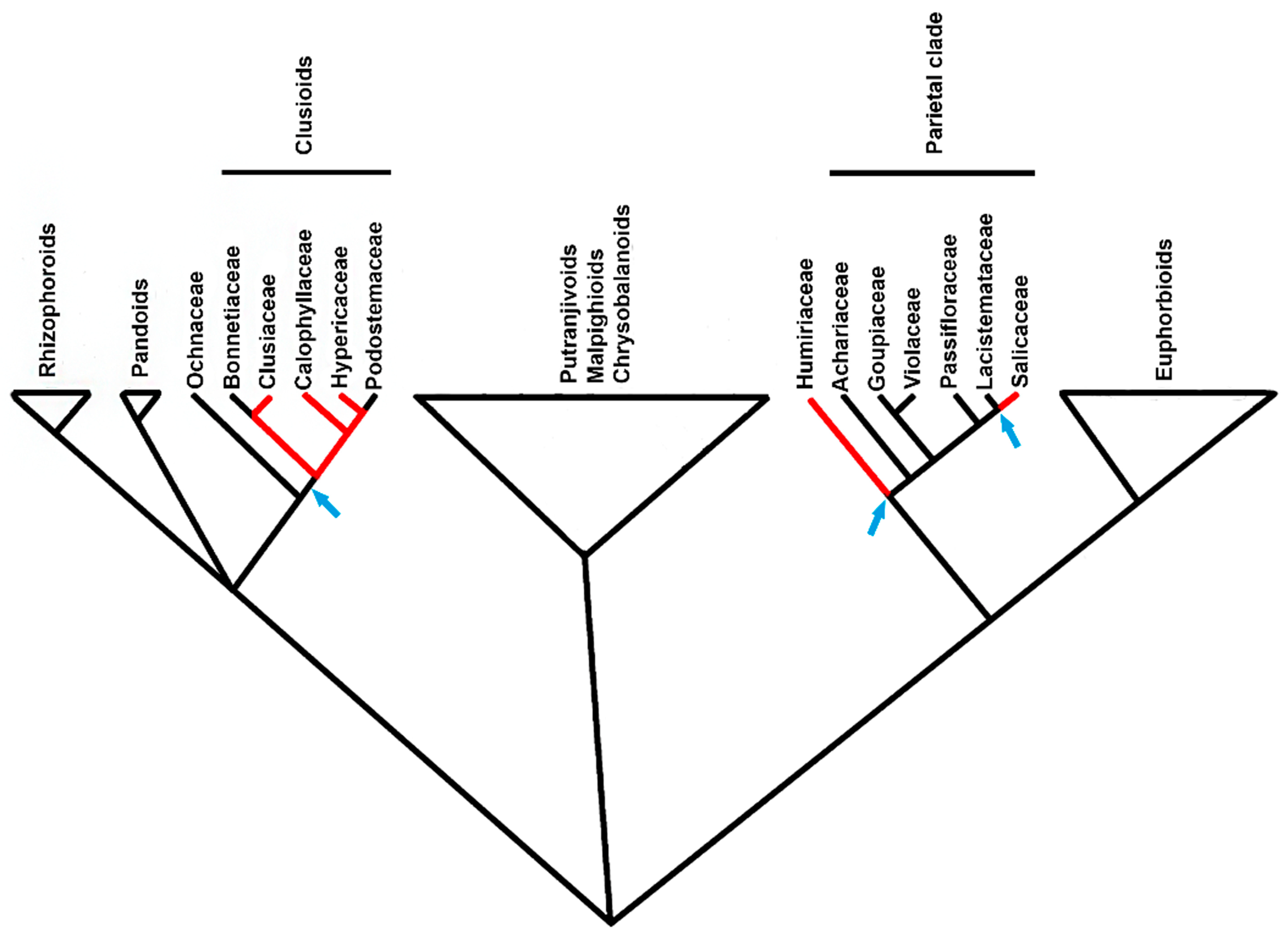
Publisher’s Note: MDPI stays neutral with regard to jurisdictional claims in published maps and institutional affiliations. |
© 2021 by the authors. Licensee MDPI, Basel, Switzerland. This article is an open access article distributed under the terms and conditions of the Creative Commons Attribution (CC BY) license (https://creativecommons.org/licenses/by/4.0/).
Share and Cite
Costa, E.R.; Tangerina, M.M.P.; Ferreira, M.J.P.; Demarco, D. Two Origins, Two Functions: The Discovery of Distinct Secretory Ducts Formed during the Primary and Secondary Growth in Kielmeyera. Plants 2021, 10, 877. https://doi.org/10.3390/plants10050877
Costa ER, Tangerina MMP, Ferreira MJP, Demarco D. Two Origins, Two Functions: The Discovery of Distinct Secretory Ducts Formed during the Primary and Secondary Growth in Kielmeyera. Plants. 2021; 10(5):877. https://doi.org/10.3390/plants10050877
Chicago/Turabian StyleCosta, Ellenhise R., Marcelo M. P. Tangerina, Marcelo J. P. Ferreira, and Diego Demarco. 2021. "Two Origins, Two Functions: The Discovery of Distinct Secretory Ducts Formed during the Primary and Secondary Growth in Kielmeyera" Plants 10, no. 5: 877. https://doi.org/10.3390/plants10050877
APA StyleCosta, E. R., Tangerina, M. M. P., Ferreira, M. J. P., & Demarco, D. (2021). Two Origins, Two Functions: The Discovery of Distinct Secretory Ducts Formed during the Primary and Secondary Growth in Kielmeyera. Plants, 10(5), 877. https://doi.org/10.3390/plants10050877







